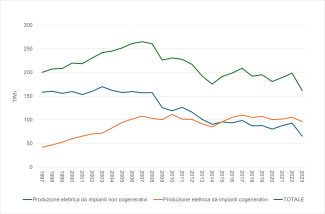Panel 1
Antonio Caputo
In 2022, the contribution of cogeneration plants to total electricity production amounted to 37.1%, while the share of cogeneration in gross thermoelectric generation reached 53.1%.
The indicator measures the electricity output of combined heat and power (CHP) plants.
To assess the contribution of cogeneration plants to total electricity production, with the aim of increasing the efficiency of energy supply.
Directive 2004/8/EC promotes cogeneration based on useful heat demand within the internal energy market and sets an indicative target for the European Union to double the share of cogeneration in total electricity production—from 9% in 1994 to 18% by 2010. The directive was transposed into Italian law through Legislative Decree No. 20 of 8 February 2007. The Ministerial Decree of 5 September 2011 establishes measures regarding the promotion of High-Efficiency Cogeneration (HEC). The Ministerial Decree of 4 August 2011 supplements the provisions of Legislative Decree No. 20/07 for the purpose of defining the criteria for the recognition of HEC qualification, effective from 1 January 201
Panel 2
TERNA S.p.A. – Statistical Data on Electricity in Italy, Various Years
Data quality assessment
Terna - Rete Elettrica Nazionale S.p.A.
TERNA S.p.A., Production and Use of Heat from Electrical Cogeneration Plants
National
1997-2022
Indicator assessment
The data is collected and processed by TERNA S.p.A.
In 2022, total gross thermoelectric energy production amounted to 198.4 TWh, of which 53.1% was generated by combined heat and power (CHP) plants (Table 1).
With respect to total gross traditional thermoelectric production, the share of cogeneration increased from 21% in 1997 to 53.1% in 2022, while cogeneration accounted for 37.1% of total electricity production (see indicator 'Electricity Production by Source'). Over the long term, there has been a clear increase in the share of electricity generated in combination with heat production (Table 1). Gross electricity generation from cogeneration rose by 150.8% in 2022 compared to 1997, whereas electricity-only generation declined by 41.2% over the same period.
Data
Table 1: Gross Electricity Production from Cogeneration Plants
TERNA S.p.A.
Table 2: Net Electricity Production from Cogeneration Plants
TERNA S.p.A.

The share of cogeneration relative to gross thermoelectric production reached its peak value in 2022, amounting to 53.1% (37.1% of total electricity production). Following the economic crisis, thermoelectric production drastically declined (-33.7% in 2014 compared to 2007). From 2015 onwards, a recovery in thermoelectric production was observed until 2017, followed by a downturn that intensified in 2020 due to lockdown measures implemented to contain the SARS-CoV-2 pandemic. Since 2021, thermoelectric production has been increasing again and in 2022 it was 9.8% higher than in 2020 (Table 1).